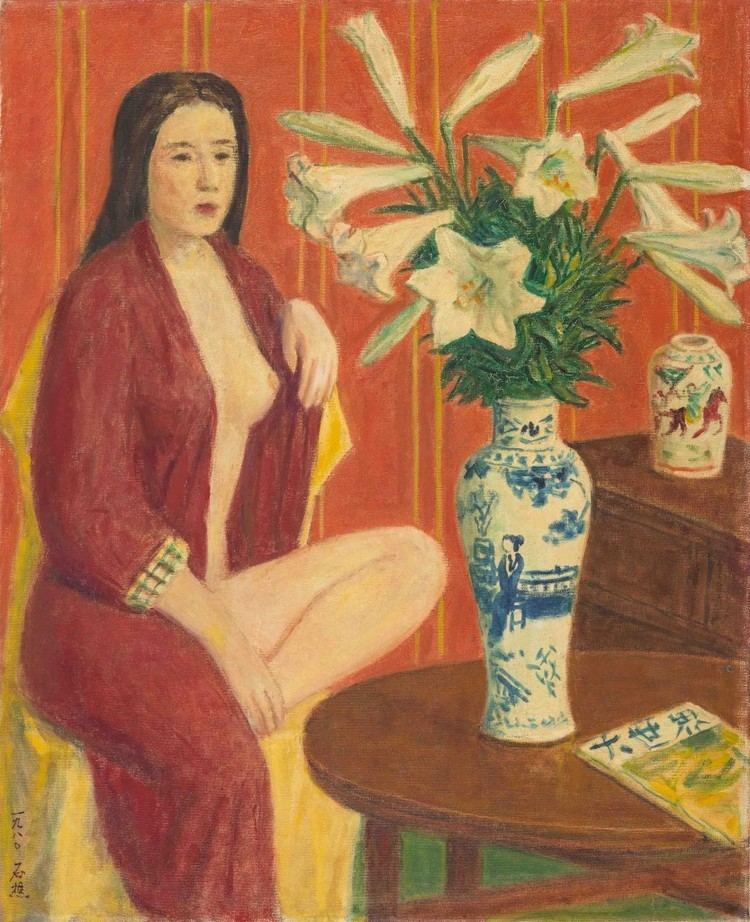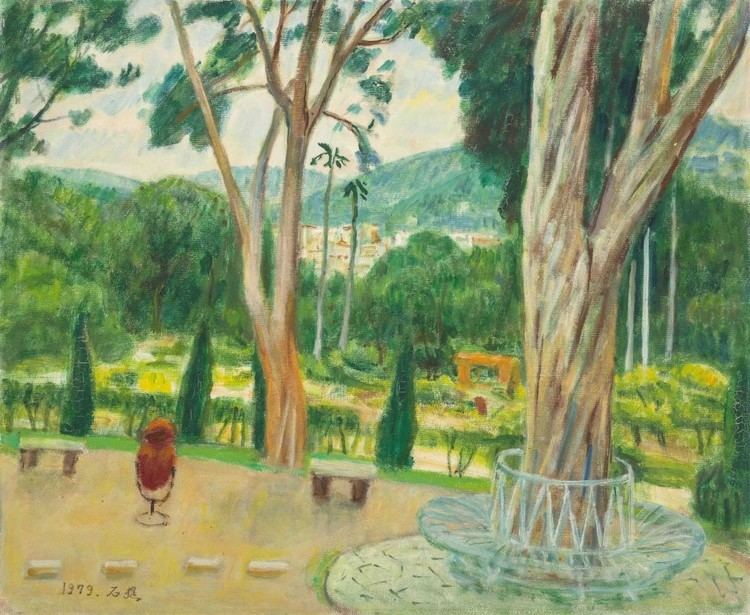Name Lee Shih-chiao | Role Artist | |
 | ||
Born July 13, 1908 ( 1908-07-13 ) Taishan, Taipei County (now New Taipei City) Education Tokyo University of the Arts People also search for Yen Shui-long, Tan Ting-pho, Liu Chi-hsiang | ||
Lee Shih-chiao (Chinese: 李石樵; pinyin: Lǐ Shíqiáo; July 13, 1908 – July 7, 1995) was a Taiwanese painter. Lee Shih-chiao was one of important Taiwanese artists early in the Japanese Colonial Period (from 1895 to 1945). Most of his paintings were realistic, but he also created some cubist works in his mid-life. He contributed significantly to art in Taiwan, as well as educating and inspiring quite a few followers who later became excellent artist. After Lee Shih-chiao’s death, more than four hundred pieces of his works, including oil paintings, water-colour paintings, sketches, and their related items, have been preserved in the Lee Shih-chiao Museum of Art. They are Taiwan’s important cultural assets and should be carefully preserved for future appreciation and study in the concept of modern arts.
Contents
- Biography
- Education
- Work and Public Life
- The Art Movement in the 1910s 1930s
- Contributions
- Former Residence of Lee
- References

Biography
Lee Shih-chiao was a famous Taiwanese oil painter born in Xinzhuang Township, Taipei County, in 1908 and died in the United States in 1995. For more than sixty years, he had been engaged in artistic creation. His serious efforts and sincere towards the creation of arts resulted many asserts in Taiwanese art culture. Moreover, his quest for originality, his contemplative mind, critical attitude and combined with his unparalleled painting skills all related and contributed to his unique painting style.
Education
In 1923, he entered Taipei Normal School (台北師範學校), which divided into two normal colleges later, and began to receive the formal art education under Ishikawa Kinichiro and become a long term participant in Ishikawa’s plein air field trips, experiences that improved his painting skills by leaps and bounds. In 1927, his watercolor painting entitled Taipei Bridge was selected for the first Taiwan Art Exhibition (Taiten).
In 1929, he went to Japan seeking admission into the Western Painting Division (renamed Oil Painting Division in 1933) of the Tokyo School of Fine Arts in 1931; he was accepted after taking the entrance examinations three times, and began to study under Okada Saburousuke. Lee graduated from the Tokyo School in 1935 and stayed in Japan until 1944.
Work and Public Life
Lee married Chou Lai-fu (周來富) in 1928. In 1933, Li's work Garden of Lin Benyuan was selected for the Imperial Art Exhibition (Teiten), and his Interior was selected for the 7th Taiwan Art Exhibition with special selection status and received the exhibition's Asahi Prize. In 1934, he participated in the establishment of the Tai-Yang Art Society.
After graduating in 1935, he remained in Tokyo and continued to develop his skills. During this period, he earned a living by painting portraits for wealthy and influential Taiwanese families. His 1936 work The Family of Yang Zhaojia is a representative work from this period in his life, and was selected for the first Shin Bunten Exhibition. In lieu of having been selected twice for Japan’s official exhibition, Li became the first Taiwanese painter to receive review exemption status for the Shin Bunten Exhibition.
In 1944, Li returned to settle in Taiwan. In 1946, his work Market Entrance was exhibited in the first Taiwan Provincial Art Exhibition, where he also served as a juror. In 1949, he used his family members as the models for his painting The Joy of Farming. This painting demonstrates the artist’s adept handling of group images as well as his skillful use of realist style. In 1948, he opened a private art studio and began to teach.
After 1950, his style began to move away from realism, and he started using Picasso-esque techniques or reverse perspective in order to manifest the subjects of his works. These changes can be seen in his works such as Still Life with Glass Vessel and Painting Studio (Lily) (1958), demonstrating the influence of Cubism on his painting.In 1963, Lee began to teach arts at National Taiwan Normal University as an associate professor. He left the Normal University in 1974, and became a professor of the National Taiwan Institute of Arts (now National Taiwan University of Arts) and the Chinese Culture University. Teaching at the Department of Fine Arts at the National Taiwan Normal University and the National Taiwan Academy of Arts, both being the most prestigious academic organisations in fine arts in Taiwan at that time. Many genius young artists have produced in Taiwan while he was working as a professor.
Lee retired from his educator jobs and moved to Seattle to live with his daughter in 1982. He moved back to Taiwan later. He died in Syracuse, New York, USA.
The Art Movement in the 1910s-1930s
During the second half of the Japanese colonial period (1895-1945), political stability and economic growth accelerated modernisation in Taiwan. In the 1930s period, the modernisation was to be positively advantaged towards artists and writers with an attitude of general cooperation. The concept of modern are bloomed with numerous art exhibitions being held and artists praised as cultural heroes even if they did not necessarily have a steady income. Many young Taiwanese dreamed of an artistic career as a way of improving their social status or of cultivating themselves with knowledge more suited to the modern society. From the late 1910s, many students started to aboard to study for the art schools of Japan.
Taiwanese artists, including painters and writers in the early stage seem to have fallen into somewhat different groupings which ignored each other. Comparable expression in painting is difficult to find. The impression still lingers today of there early modern painters being no more than decorators of the colonial period. Throughout the colonial period, the education system was pragmatically oriented to support the effective government and economic productivity of the island. Most leaders in the cultural movement were the younger generations which received the formal education in Japanese and its higher education from Japan. This is because, there were only three middle schools for Taiwanese students until the mid-1920s. This explains why to get an education many young and genius Taiwanese students had to leave for Tokyo, or other cities in Japan or even in China. Education abroad was basically carried out through individual self-motivation and family support.
Throughout the colonial period no art school was formally established within the island. Preparation of work for exhibitions was about the best training provided for a young art student who could not afford to study elsewhere. The first formal painting exhibition was founded by the Japanese colonial Government-General, and 1938-44. Its conception was essentially borrowed from the Japanese Imperial Art Academy Exhibition.
The Western style of painting section was characterised by works of middle and normal school students, but with the confidence gained from the exhibition’s popular reception, famous painters from Japan were invited to join the judging committee as guest members in successive years, and the exhibition hall was entirely open to works by enthusiastic young art students. For many Taiwanese, the exhibition hall was seen as an exciting stage for an island-wide contest between young Japanese and Taiwanese artist who were mostly in their early twenties and late teens. Two Taiwanese from the Tokyo School of Art took the special prizes in the Western-style painting division. It followed almost the same rules as Taiten but with a narrower focus- only oil painting was accepted in the first six years.
The art societies’ movement in the mid-1930s continued to spring new surprises. In 1936, five Taiwan born young Japanese painters, many of whom were related to the Independent Art Association in Tokyo, organised their first group exhibition, the Association of Newly Flourishing Oil Painting.
Contributions
Lee Shih-chiao have dedicated his entire life into the art and engaged in art creation for more than sixty years. With powerful determination and invulnerable spirit, he painted and remained many excellent works, which form the most complete collection of western-style paintings in Taiwan at his time. Nowadays, these pieces are considered Taiwan’s treasure. As many as four-hundred-plus oil paintings, water-colour paintings, and other related data are now collected in the Lee Shih-chiao Museum of Art (see below for a portion of his digitalised works).
• Lee Shih-chiao and other seven artists (Chen Dengpo, Li Meishu, Yen Shuilong, Yang Sanlang, Liao Jichun, Chen Chingfen, and Zhang Wanchuan) co-founded the Taiyang Art Society and Taiwan Art Exhibition Association, which contributed significantly to the development of art in Taiwan.
• Art historian Xie Lifa once said, “In Taiwan’s art history, Lee Shih-chiao was like as a bridge. He translated the unique elements in Western masterpieces into general conventions, building a passage that makes the art of painting approachable.” This statement acknowledges Lee’s immense contributions in leading the artists of new generations.
• Art historians hailed him as a prize winner in the Di Exhibition (Japan’s national exhibition) and Fine Taiwan Art Exhibition.
The Council of Cultural Affairs has had two-hundred-plus pieces of Lee’s digitalised artwork . In light of Mr. Lee’s contributions to Taiwan’s art and for education purpose, his outstanding accomplishments should be thoroughly documented and digitalised, and furthermore be open to the general public. Therefore, his legacy can be carried on, and so does his selfless devotion into education. The Digital Archives Project aims to establish the “Lee Shih-chiao Digital Museum” by digitalising the collection in the Lee Shih-chiao Museum of Art. The main tasks are as follows:
• Data compilation and analyses: compile and categorise the paintings, manuscripts, and related data systematically and chronologically, conduct researches on Lee Shih-chiao’s artist career and painting styles as well as analyses of his intentions behind each of his art creations.
• Data digitisation: digitalise the related items step by step Establishment of Metadata: establish metadata according to standards such as Dublin Core, CDWA, EAD, and RDF.
Former Residence of Lee
In 15 years old, Lee Shih-chiao moved out of the house in Xinzhuang. The house was bought by a timber-factory-running family named Huang. The Huang family built factories around the house but kept the house from damaged. They did not know the house belonged to Lee Shih-chiao's family until they found his name in the land ownership certificate. Few people know that the house is Former Residence of Lee until the Huang family decided to register the house as a historical sites to protect it because the area where the house is located is planned to be redeveloped in a land readjustment project.
